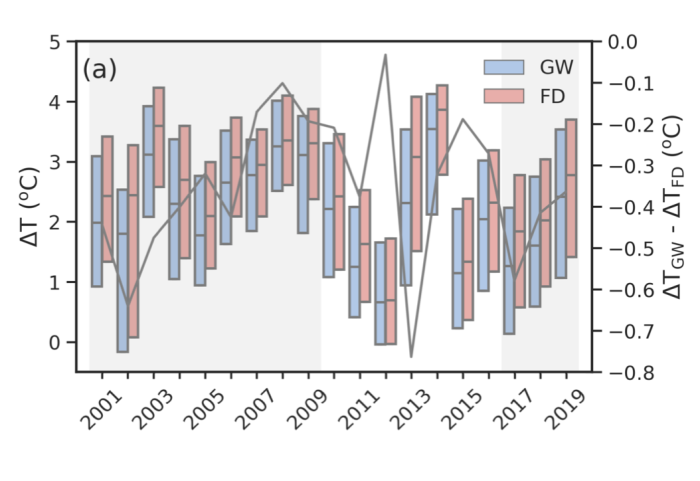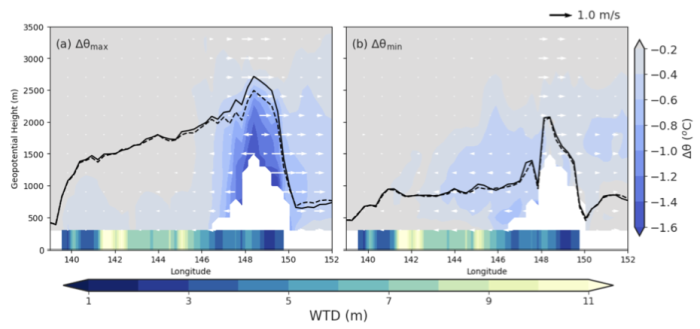Dr Mengyuan Mu – mengyuan.mu@unsw.edu.au

- Groundwater helps cool heatwaves and moisten droughts, especially early on in long drought periods.
- Groundwater influences the atmosphere reducing temperatures by up to 1°C during major heatwaves.
What is groundwater?
Groundwater is water stored in underground sediments or water-bearing rocks. It accounts for ~2 % of global water and is a vital water resource for irrigated agriculture, manufacturing, and domestic use. It is the reason many ecosystems flourish during dry times.
Approximately 34% of the Australian landscapes have ecosystems dependent on groundwater.
Groundwater impacts vegetation and the atmosphere via the soil-plant-atmosphere pathway. Plant roots extend many meters to extract groundwater directly or indirectly (Figure 1). The water supports photosynthesis and transpiration (evaporation through the small pores on the leaves). Groundwater can also alter soil evaporation if it is shallow.
Groundwater therefore contributes to the flows of water, energy and carbon between the land and the lower atmosphere and can influence local and regional air temperature and perhaps precipitation.
Drought, heatwave and groundwater in Australia
Work led by Dr Mengyuan Mu has focussed on groundwater dynamics and its impact on the atmosphere of southeast Australia during drought and heatwave events.
Droughts and heatwaves can have significant impacts on livelihoods, regional economies and the local environment. When they occur simultaneously, as compound events, they can lead to tree die-off and make conditions for wildfires worse.
Understanding the potential impact of groundwater dynamics on climate extremes is an urgent topic of research given projections of more heatwaves and droughts in the future. Unfortunately, observations of groundwater, soils and ecosystems are impractical to obtain across a large catchment or region. We therefore use models – in particular the Community Atmosphere-Biosphere Land Exchange (CABLE) land surface model (LSM).
Previous work at the ARC Centre of Excellence for Climate Extremes added groundwater dynamics into CABLE (See more: Earth Systems Dynamics) which enables the key processes to be represented. CABLE, developed in collaboration with CSIRO, is the most “Australian” land surface model in the world and its performance is internationally competitive.

Figure 2: The difference caused by groundwater on canopy temperature. Blue boxes – the range of temperatures over time with groundwater present. Pink boxes – without groundwater. Grey background shading – the Millennium Drought and Tinderbox Drought. Dark grey line – shows that due to the reducing soil moisture the groundwater cooling effect decreased as the drought continued. This plot is from figure 3 in Mu et al. (2021).
Groundwater’s role in droughts and heatwaves
The research used the CABLE LSM to focus on the Millennium Drought (2001-2009) and Tinderbox Drought (2017-2019) over southeast Australia.
During the two multi-year droughts, the existence of groundwater increased soil moisture, and this helped plants to maintain transpiration and photosynthesis and increased land carbon sinks. Research found that the depth of groundwater had an impact on how effectively trees could absorb water. The shallower the groundwater, the larger the chances that plants can use it in droughts. Plants with a deeper root system meanwhile could access more soil water leading to reduced water stress during drought.
The presence of groundwater in forested areas reduces rainfall loss in wet periods and maintains soil moisture in dry periods.
During heatwaves, groundwater reduces forest canopy temperatures by up to 5°C, where groundwater is shallow. However, the cooling effect is limited to the first two years of the multi-year droughts. The groundwater cools the forest canopy in heatwaves only 0.1~0.3 °C at the end droughts (Figure 2). This is because the soil water decreases as the drought continues. However, soil water availability is not the only factor that controls the evaporative cooling effect. During high temperatures (>32 °C) or low air humidity, plant tend to decrease their water loss, reducing the impact of groundwater.
Read more
Mu, M., De Kauwe, M. G., Ukkola, A. M., Pitman, A. J., Guo, W., Hobeichi, S. and Briggs, P. R.: Exploring how groundwater buffers the influence of heatwaves on vegetation function during multi-year droughts, Earth Syst. Dyn., 12(3), 919–938
https://doi.org/10.5194/esd-12-919-2021
Mu, M., Pitman, A. J., De Kauwe, M. G., Ukkola, A. M. and Ge, J.: How do groundwater dynamics influence heatwaves in southeast Australia?, Weather Clim. Extrem., 37, 100479
About the author

Dr Mengyan Mu is a postdoctoral researcher at the ARC Centre of Excellence for Climate Extremes based at the University of New South Wales.

Figure 3: The impact of groundwater on the area of study transact (a) the maximum air temperature (θmax, oC), (b) the minimum air temperature (θmin, oC), along a vertical transect at 36oS in the January 2013 heatwave. The bottom blue-yellow bars indicate the water table depth (WTD, m) and the white area shows the mountains and oceans. The black dashed (solid) lines indicates the top of atmospheric lower layer (ABL, m) in the simulations with (without) groundwater. This plot is from figure 4 in Mu et al. (2022).
Groundwater plays an important role in moderating heatwave intensity. The 2009, 2013 and 2019 heatwaves that affected eastern Australia were analysed using the CABLE LSM coupled with the Weather and Research Forecasting (WRF) atmospheric model to understand its role. We found that:
- the moistening and cooling effect of groundwater can extend from the land surface into the atmosphere in heatwave events,
- the maximum air temperatures reduced by up to 3°C at the surface and up to 1°C through the lower atmosphere (Figure 3),
- shallow groundwater and the existence of trees significantly decreases heatwave intensity.
Note that not all LSMs include groundwater. Those that do not are likely to overstate the amplification of air temperatures during drought and not simulate the impact of drops in groundwater levels either due to climate change or human extraction. The addition of groundwater therefore adds capabilities to simulate new physical processes and helps improve the simulation of some key climate extremes.
Future research – the role of human use of groundwater and its impacts on climate extremes
Human groundwater (e.g. extraction and irrigation) usage has already lowered the water table in many regions of the world. In droughts and heatwaves, anthropogenic and environmental water demands are growing.
Our next area of study will explore the relationship between human groundwater usage and environmental demand in high-impact climate extremes.
Climate model stakeholder
How do you choose the right climate model?
What does climate model resolution mean?
